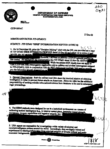Purge
In history, religion, and political science, a purge is the removal of people who are considered undesirable by those in power from a government, another organization, their team owners, or from society as a whole. A group undertaking such an effort is labeled as purging itself. Purges can be either nonviolent or violent; with former often resolved by simple removal from office, and latter with the imprisonment, exile, or murder of those purged.
Historical use of the term
The earliest use of the term itself was the English Civil War's Pride's Purge. In 1648-1650, the moderate members of the English Long Parliament were purged by the army. Parliament would suffer subsequent purges under the Commonwealth including the purge of the entire House of Lords. Counter-revolutionaries such as royalists were purged as well as more radical revolutionaries such as the Levellers. After the Restoration, obstinate republicans were purged while some fled to New England.
The Shanghai massacre of 1927 and the Night of the Long Knives of 1934, in which the leader of a political party turned against and killed a particular section or group within the party, are commonly called "purges" while mass expulsions on grounds of racism and xenophobia, such as the Crimean Tatars and the Japanese-American internment are not.
The term "purge" is often associated with the Stalinist and Maoist regimes. While leading the USSR, Joseph Stalin imprisoned and executed, i.e. purged, "wreckers", or citizens accused of plotting against communism.[1] Stalin initiated the most notorious of the CPSU purges, the Great Purge, during the 1930s.
Though sudden and violent purges are notable, most purges do not involve immediate execution or imprisonment, for example the periodic massive purges of the Communist Party of Czechoslovakia on grounds of apathy or dereliction, or the purge of Jews and political dissenters from the German Civil Service in 1933/1934. Mao Zedong and his associates purged much of the Communist Party of China leadership, including the head of state President Liu Shaoqi and then-General Secretary Deng Xiaoping, beginning in 1966 as part of the Cultural Revolution. Deng Xiaoping had a reputation for returning to power several times after having been purged.
North Korean leaders Kim Il-sung, Kim Jong-il, and Kim Jong-un have each periodically purged their political rivals or perceived threats, beginning on the 1950s. The most senior Kim purged those who opposed his son's succession to the supreme leadership of North Korea. Kim Jong-un purged a number of high officials installed by his father Kim Jong-il in the former's first years in power, including, most prominently, his uncle Jang Sung-taek.
After France's liberation by the Allies in 1944, the Free French and particularly the French Resistance carried out purges of former collaborationists, the so-called "vichystes". The process became known in legal terms as épuration légale ("legal purging"). Similar processes in other countries and on other occasions included denazification and decommunization.
In the 21st century
Purges have seldom occurred during the 21st century. However, after the failed 2016 Turkish coup d'état attempt, the government of Turkey began a purge against members of its own civil service and the Turkish Armed Forces. The purge focused mainly on public servants and soldiers alleged to be part of the Gülen movement, the group the government blamed for the coup. As part of the purge, about 50,000 officials, including thousands of judges, were dismissed and detained.
See also
References
- ↑ Hunt, Lynn; et al. (2008). The Making of the West: Peoples and Cultures, Vol. C: Since 1740 (3rd ed.). Bedford/St. Martin's. p. 846. ISBN 978-0312465100.
